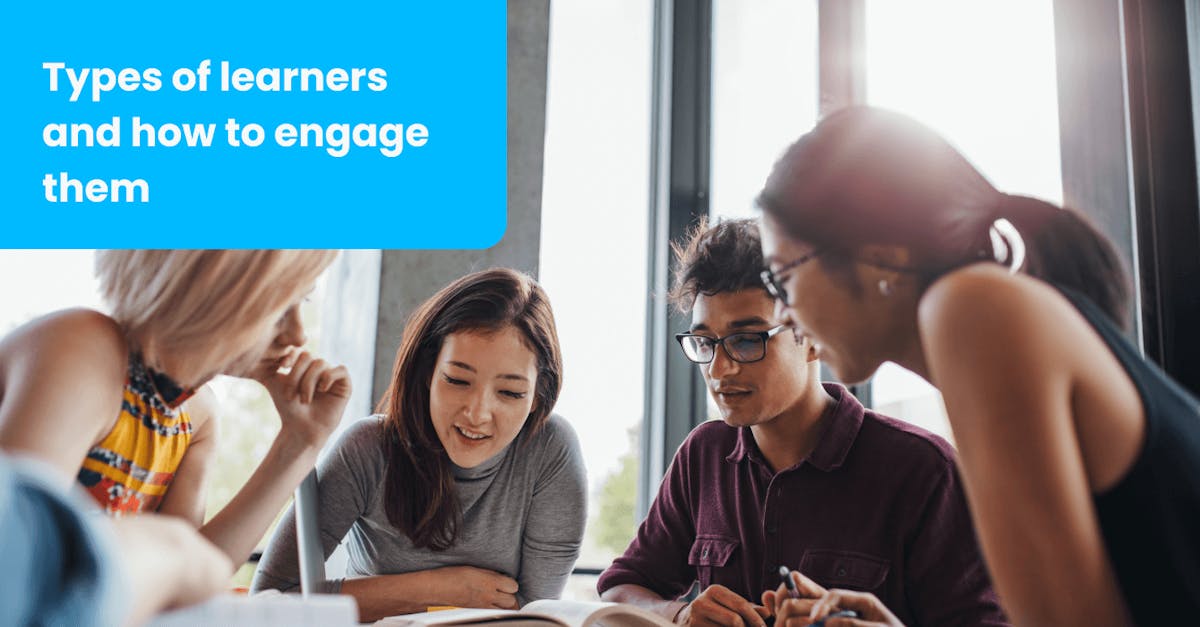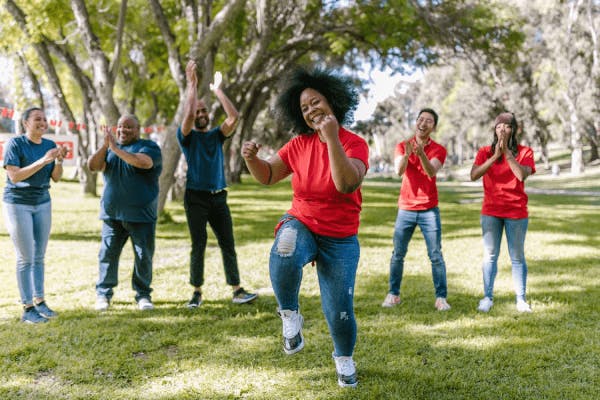4 Types of learners and how to engage them

Learning is an important aspect of human life, and everyone has their own unique way of acquiring knowledge. While some prefer visual aids, others prefer hands-on activities. It’s critical to understand the different types of learners so you can tailor teaching methods to suit their preferences for more effective learning.
Learner Type 1: Visual learners
Visual learners are learners who prefer to process information through images, charts, and diagrams. They often have a keen sense of observation and can easily visualize concepts in their minds. Visual learners typically have good spatial reasoning skills, which means they can easily understand how objects relate to each other in space.

To engage visual learners, trainers should incorporate more visual aids such as images, videos, and diagrams into their learning materials. Visual learning style examples should be clear and concise, with minimal distractions, to avoid confusion. Trainers can also use mind maps or graphic organizers to help visual learners organize their thoughts and ideas.
Visual learners also benefit from color-coding and highlighting important information. This can help them remember important details and retain information better. Your trainers can also use whiteboards and interactive displays to give visual learners a more interactive learning experience.
But it's important to note that not all visual learners learn the same way. Some may prefer a more hands-on approach, while others may prefer to work independently. Take the time to understand each visual learner's preferences and adjust their teaching methods accordingly.
Alongside traditional classroom materials, having online resources such as videos and interactive websites is also a good idea. These resources give a more engaging and dynamic learning experience that can help visual learners better understand complex concepts.
One tool that you can use to cater to your visual learners is EdApp. EdApp empowers trainers to tailor learning content and activities to the needs and preferences of their trainees. You can make beautifully designed courses and activate the full potential of your visual learners with EdApp’s courses. This is all thanks to their user-friendly and beginner-friendly authoring tools.
Sign up for this learning tool today.
Learner Type 2: Auditory learners
Auditory learners process learning content better through sound and verbal communication. You can easily identify them by their strong listening skills. They are also likely to be effective communicators and enjoy group discussions and debates.

Engaging auditory learners is easy. Have your trainers incorporate more verbal instructions and explanations into their teaching materials. They can also use lectures, podcasts, and audio recordings to give auditory learners the information they need.
Focus group discussions and brainstorming sessions can be good to consider as different types of learning methods. Here, your learners can actively participate in the learning process and engage with their peers. Activities and games involving verbal communication also help auditory learners retain information.
It's important to note that not all auditory learners learn the same way. Some may prefer to work independently, while others may thrive in group settings. Teachers should take the time to understand each auditory learner's preferences and adjust their teaching methods accordingly.
For supplementary learning materials, you can engage your learners by adding podcasts and audiobooks. While they’re longer resources for learning, they can give them more detailed information that may be hard to get during lectures and focus group discussions.
Learner Type 3: Kinesthetic learners
Kinesthetic learners, also known as tactile learners, are individuals who learn best through hands-on experiences and physical activities. They tend to have high levels of energy and enjoy exploring and learning through touch and movement. Kinesthetic learners are often natural athletes or dancers and have excellent coordination and motor skills.

To engage kinesthetic learners, trainers should use hands-on activities, such as experiments and demonstrations, that allow them to actively participate in the learning process. Field trips, simulations, and role-playing activities can also be effective in engaging kinesthetic learners. These activities help them understand and retain information better by connecting it to physical experiences.
EdApp includes a variety of interactive activities such as quizzes and games that would be good to use for your kinesthetic learners. These templates can be added to any course in their course library or to a course you create from scratch.
Kinesthetic learners can also benefit from taking notes during lectures and presentations. This process helps them engage with the information and commit it to memory. It's important to note that kinesthetic learners may struggle with traditional teaching methods that require long periods of sitting and listening.
Kinesthetic learners may also have a hard time learning through reading and writing alone, as they prefer to engage with the material through physical activity. Trainers can accommodate this learning style by incorporating visual aids and physical demonstrations into their lessons.
Learner Type 4: Reading/writing learners
Reading/writing learners tend to have strong language skills and enjoy analyzing written material. They love taking notes during lectures and presentations and often rely on textbooks and written materials to learn new information. For those who fall into this category and are looking to expand their language skills, consider exploring opportunities to learn Spanish online for a diverse and engaging learning experience. Additionally, in order to boost your German language skills, you could take advantage of online resources aimed at improving reading and writing proficiency in German.

They often struggle with visual aids or hands-on activities that don’t involve writing or reading. Your trainers need to use a variety of teaching methods to engage all learners, but they should focus on giving written materials and assignments for reading/writing learners. Some materials your trainers can hand out are textbooks, articles, and handouts. They should also encourage reading and writing assignments that allow learners to analyze and evaluate information on their own.
Reading/writing learners often have excellent memory skills and can retain large amounts of information by reading and writing about it. They also enjoy discussion and debate about written material, which can help them better understand the material and retain it for longer periods of time.
Training Techniques for Learners with Various Learning Styles
Training a team with diverse learning styles can be difficult, but there are several strategies you can take to make it more effective. Here are a few suggestions:
- Use a variety of teaching approaches: Use a variety of teaching methods to accommodate different learning types. Visual aids, group discussions, hands-on exercises, and audio resources are examples of such items.
- Give some learning options: Deliver different ways for learners to get knowledge and accomplish activities. You can, for example, present both written and audio instructions, or allow learners to select between watching a video and reading a text.
- Accommodate different learning speeds: Recognize that different learners may have varying learning speeds and tailor their training accordingly. For example, your trainer might need to spend more time explaining topics to visual learners or give kinesthetic learners extra practice tasks.
- Activate active learning: Incorporate interactive activities such as role-playing, group projects, and quizzes to engage students and cater to diverse learning styles.
- Supply regular feedback: Offer learners regular feedback on their progress and performance. This can help your team identify their strengths and limitations and adjust their learning approach as needed.
Author
Stephanie Escuadro
Stephanie is an eLearning content writer for EdApp, a microlearning solution designed for today's digital habits. She creates content about cutting-edge learning technologies and resources to help companies deliver great training experiences. When not absorbed in writing, she spends her time taking care of her dog and binge-watching.
